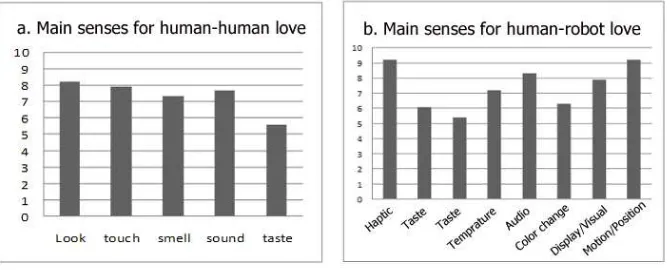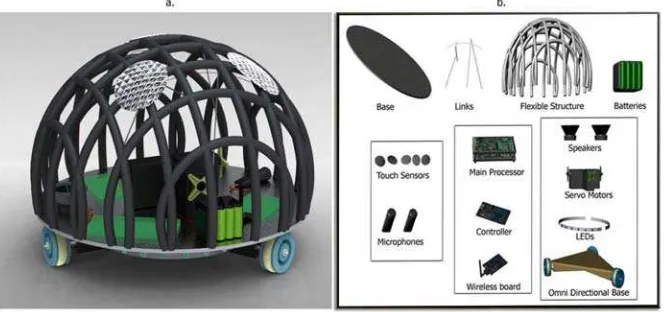Hooman Aghaebrahimi Samani1,2, Adrian David Cheok1,2, Mili John Tharakan2, Jeffrey Koh1,2, and Newton Fernando2
1 Graduate School for Integrative Science and Engineering,
National University of Singapore
2 Keio-NUS Cute Center,
National University of Singapore and Keio University, Japan {hooman,elecad,idmmjt,g0901851,idmfonn}@nus.edu.sg
Abstract. We refer to human-robot relationships as Lovotics. In this paper a design process for Lovotics is presented. In order to invoke these relationships, technological solutions can only take us so far. Design played an important role in order to engage users to explore the possi-bilities of bi-directional, human-robot love. We conducted a user-centric study in order to understand these factors and incorporate them into our design. The key issues of design for developing a strong emotional connection between robots and humans are investigated. A questionnaire is proposed and based on the results of this a robot with minimal design is developed.
1
Introduction
Lovotics is a research domain for developing a love-like relationship between humans and robot. This multidisciplinary research investigates various scien-tific issues regarding human-robot love. One of the primary requirements of the Lovotics research is to design a robot that loves and is loved by humans. ”Love” is an abstract term. The first and most trying difficulty regarding our project was to outline a definition for the very emotion we wanted to simulate. Because of this, we decided to begin with a textbook definition of the term in order to frame our research. If we could recreate this emotion within a robot at its ba-sic definition, we felt that we could then begin to design new definitions of the term which included robots in the picture. As such, we have used the following definition by Aristotle as a starting point:
̏Philia (ϕιλ´ια), a dispassionate virtuous love, was a concept developed by Aristotle [1]. It includes loyalty to friends, family, and community, and requires virtue, equality, and familiarity. Philia is motivated by practical reasons; one or both of the parties benefit from the relationship. It can also mean love of the mind [2]. Philia entails a fondness and appreciation of the other. For the Greeks, the term Philia incorporated not just friend-ship, but also loyalties to family and polis-ones political community, job, or discipline [3].˝
M.H. Lamers and F.J. Verbeek (Eds.): HRPR 2010, LNICST 59, pp. 118–125, 2011.
2
System Design
Lovotics is the beginning of a series of work that explores the notion of bi-directional Human - Robot love. We see this mutual relationship and love as the future of robotics, where we envision a world as a place where humans have robots as friends and possibly even life partners. To achieve this relationship, we developed Lovotics, a love robot that aims to capture the essence of a Philia relationship and translate that for robotics to enable this relationship to grow between robots and humans.
The results of our questionnaire show varied responses to how someone ex-presses or feels love. We have taken a multidisciplinary approach to understand the basic elements to ’love’ and recreated this in Lovotics robot. We have iden-tified the senses - tactile, audio and visual, as the basic key senses used for expressing and feeling love.
Donald Norman introduced three levels of processing in design - visceral, behavioral and reflective [4]. These three levels of design are inter-related and the success of a product is usually determined by how good the design is at these three levels.
I. Visceral design is dominated by how products look, feel and even sound. The underlying principles are usually hard-wired in, consistent across people and culture. For Lovotics, there is a need for it to encourage sociability with human being and thus its appearance is key as well as its tactile, audio and visual input and output.
II. Reflective design is about what the product means to the user, the message it brings across and its cultural impact. For Lovotics, the meaning will be to create a robot that loves the user and evoke feelings of love from him/her and the vision is to create a culture of love with robots, changing the human perception of robot beings without feeling.
III. Behavior design is about how the product performs. Good behavior design has four main components: function, understandability, usability and physical feel. For Lovotics, its main aim is to infer sociability with humans through love with interactions that are comprehensible and intuitive.
Affordance is a psychological terms that means giving a message from the object [5]. It defines the intuitiveness of the object and makes it easier to un-derstand where the function of the product is. When the affordance of an object or environment corresponds with its intended function, the design will perform more efficiently and will be easier to use. Lovotics robots need to immediately give the message to the user of its function and purpose.
The uncanny valley [6] needs to be avoided and a more simplified represen-tations of characters for the robot may be more acceptable to the human brain than explicitly realistic representations.
3
Pre-evaluation Survey
perceive love and objects. In order to do so we wanted to first pose questions that would instigate memories of love and being loved from a human-to-human context. Focusing on personal perspective, we designed questions that would en-gage the participant’s previous experiences in order to prepare them for our next set of questions.
In the second half of the survey, we wanted to get responses regarding whether or not people could get comfortable with the idea of loving robots. These ques-tions mostly dealt with whether they could imagine loving a robot, list some of their favorite objects and what words they would use to define love with objects. These questions helped us define a behavioral model when designing the robot. Lastly, we wanted to get a more concrete understanding of the embodiment of physical qualities within an object when imagining a robot that could love and be loved. These questions helped us define a physical design for the robot, and also helped us define other modes of expression that the robot needed in order to engage with real humans.
The following are results from a survey completed by 70 participants of various age, race, occupation and sex. The survey was conducted over the internet and participants were found through various social networking channels.
Fig. 1.Questionnaire results for main sensory channels for Lovotics. a. Modalities for human-human love b. Modalities for human-robot love.
From our pool of participants, less then half could not imagine loving a robot. A majority of the participants though were at least open to the idea, with 19% of participants actually believing that they could love a robot. These answers contrasted somewhat when the pool of participants were asked if they could in turn be loved by robots, with 77% open to being loved by robots. People are more willing to be loved and then to love, it seems.
Fig. 2.Questionnaire results for human-robot love imagination. a. Accepting to love a robot b. Accepting to be loved by a robot.
outcomes, where haptic, audio and motion played more important roles then smell, taste and color change.
4
Design
According to key design issues and questionnaire results, the function and form of the robot was designed. Love in itself is intangible and very personal. If we consider the Philia love, there is a sense of nurturing that is part of this rela-tionship, and it is natural for us to be attached to someone or something that we nurture [7]. We wanted to evoke this nurturing capability in both humans and robots through our design and through this develop the sense of attachment that leads to Philia love.
4.1 Form and Function
Communicating any sense of feeling let alone a synthetic expression of love is quite a challenge, to say the least. To feel and express emotions, a combination of signals engaging all the senses is important. Sound, touch and vision would all play a part in the success of our intended solution. With such a monumental task set before us, we attempted to address all modalities in order to create a framework for an expression of synthetic love. With the hopes to develop a new emotion where being ”human” is not necessarily a requirement, we started where we thought attraction would make its initial impact and developed a form that was pleasing not only to behold but to hold as well.
unisex using a simple and clean design. Males should love it more for its novel technology and females should love it more for its display of affection.
Referring to the results of our survey we found that middle-aged people be-lieved that between human-to-human interpersonal affection, looks (physical ap-pearance) and and touch (tactile feeling) were most important, closely followed by sound. In contrast, haptic and motion/position feedback was most important when discussing main sources for human-to-robot affection. The results of the questionnaire also showed that people preferred an organic shape to a geomet-ric one for the robot. With these results taken into account, a form that was curvilinear and pleasing to the eye was developed. We made the robot quite compact, almost infantile or pet-like in size and dimension to instigate a feeling of smallness and fragility - something that one would like to nurture and take care of.
As it is supposed to fit in the hand, the size of the Lovotics robot should be small. Smaller things are likely perceived to be cute, less threatening and humans have the tendency to protect smaller things. Being small also allows the user to carry the robot with them. In addition to small, it should also be light in coherence with its size. A perception mismatch may be detrimental as all the positive feelings associated with being small may be diminished if the Lovotics robot is heavy. In addition, it is supposed to interact with the user at close proximity and it has to fit in the visual field of the user to capture his/her attention [10].
The choice of color can vary as different people like different colors. Pink or red could be a choice as they are representative of love [11],[12]. It is recommended that white or blue can be used as the primary color with some shades of other colors at some features. Blue is found to be the favorite color of many people and white is a color that induces trust [13]. In addition, the robot can be personalized by the user using accessories. By accessorizing the robot, the user can build up an ownership and develop more of a liking for the robot. This also allows the user to distinguish his/her robot from others.
4.2 Developed Robot
According to the proposed process, a robot was designed as presented in Fig. 3 and 4.
Fig. 3.a. Designed robot b. Hardware components
The robot is equipped with microphones and speakers for audio interaction with the environment. Also touch sensors are implemented on the surface of the robot for tactile interaction. The robot is connected to the server where all computation is processed.
The robot uses servo motors to actuate a vertical and tilting movement by virtue of applying force on its flexible endoskeleton design. Translational and Rotational motion is realized with a mobile base.
The presented robot is the first version of the Lovotics robot and initial user studies showed positive feedback from users regarding the developed robot. We are perusing our research of design and development of the robot and will ex-amine our new design with proper user studies.
4.3 Behaviors
The robot is capable of six basic behaviors: Moving up and down to change heights, Rotation, Navigation in two dimensional space, vibration, changing color and tilting. Combination of these behaviors can be employed to express different emotions. These basic six behaviors are illustrated in Fig. 5.
5
Future Work
Fig. 4.Developed robot with its soft, spongy skin
Fig. 5.Lovotics Basic behaviors
in the future, and tough questions such as ’how does this change our definition of love?’ or ’is this kind of love appropriate?’ need to be addressed. The way to do this is to continue this study in exploring ’love’ and studying how man and machine are evolving into a new identity and relationship and to create a range of Lovotics robot to tackle these issues.
Acknowledgement
This research is carried out under CUTE Project No. WBS R-705-000-100-279 partially funded by a grant from the National Research Foundation (NRF) ad-ministered by the Media Development Authority (MDA) of Singapore.
References
1. Joachim, H., Rees, D.: Aristotle: The Nicomachean Ethics. Clarendon Press, Oxford (1951)
3. Soble, A.:Eros, agape, and philia: readings in the philosophy of Love. Paragon House Publishers (1989)
4. Norman, D.: Emotional design: Why we love (or hate) everyday things. Basic Civitas Books (2004)
5. Norman: Affordance, conventions, and design. Interactions 6(3), 38–43 (1999) 6. Mori, M.: The uncanny valley. Energy 7(4), 33–35 (1970)
7. Turkle, S.: A nascent robotics culture: New complicities for companionship, vol. 6, p. 2007 (2006) (On-line article, retrieved January)
8. Wellmann, K., Bruder, R., Oltersdorf, K.: Gender designs: aspects of gender as found in the design of perfume bottles. In: Design and emotion: the experience of everyday things, p. 87 (2004)
9. Xue, L., Yen, C.: Towards female preferences in design–A pilot study. International Journal of Design 1(3), 11–27 (2007)
10. Silvera, D., Josephs, R., Giesler, R.: Bigger is Better: The influence of physical size on aesthetic preference judgments. Journal of Behavioral Decision Making 15(3), 189–202 (2002)
11. McDonagh, D., Hekkert, P., van Erp, J., Gyi, D.: Design and emotion: The expe-rience of everyday things. CRC, Boca Raton (2004)
12. Jirousek, C.: Psychological implications of color,
http://char.txa.cornell.edu/language/element/color/color.htm



